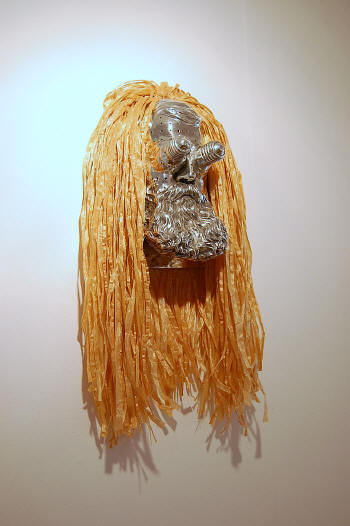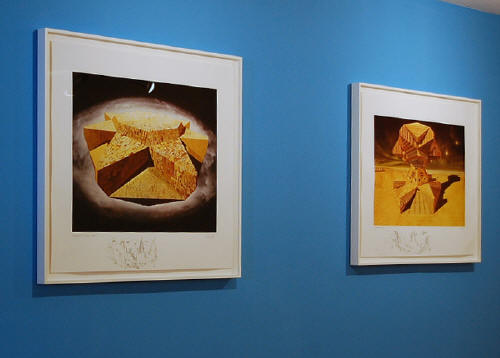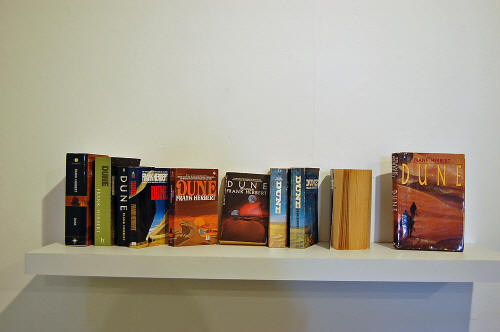|
Alejandro Jodorowsky's
'Dune: An exhibition of a film of a book that never was
Plymouth Arts Centre 2 April – 16 May 2010
 Dune is a weighty Science Fiction novel written by Frank Herbert
and published in 1965. The cover blurb by Arthur C. Clarke says its “unique
among SF novels. I know nothing comparable to it except The Lord of the
Rings”. Dune is a weighty Science Fiction novel written by Frank Herbert
and published in 1965. The cover blurb by Arthur C. Clarke says its “unique
among SF novels. I know nothing comparable to it except The Lord of the
Rings”.
There have been several attempts made to film the book, and the rights
to it have passed through several hands. It has been the subject of a TV mini-series,
and a new cinema version is currently being planned, to be directed by
action specialist Pierre Morel.
1984 saw David Lynch's version of the book. Lynch's Dune was
not well-received by critics and performed poorly at the American box
office. Lynch distanced himself from the project, stating that
pressure from both producers and financiers restrained his artistic
control and denied him final cut
privilege.
In some versions of the film Lynch's name is replaced in
the credits with the name of a fictional director
Alan Smithee: a pseudonym used by directors who wish to be
disassociated from films they have worked on. In fact, like a lot of bad
sci-fi, David Lynch’s Dune retains a fairly large cult following.
Before Lynch, in 1976, Alejandro Jodorowsky was given the job of directing the film. He
gathered around him a group of collaborators including the Swiss
artist HR Giger, who later designed the movie Alien, the French graphic
novel artist Moebius, and English sci-fi artist Chris Foss. Pink Floyd were
to provide the soundtrack and the proposed cast was to feature Orson
Welles, Mick Jagger, David Carradine and Salvador Dali. Dali was to play
the Emperor of the Universe who ruled from a golden toilet-cum-throne in
the shape of two intertwined dophins, their mouths designed to receive,
respectively, urine and excrement: “Dali considers
it very bad taste to mix piss and shit”.
But Jodorowsky never got the finance and the project was abandoned. All
that survives are the director's notes and production drawings by Giger,
Moebius and Foss.
 Jodorowksy has written about his adventures in film-making as a process
of spiritual discovery and has said film-making should be a way of
losing money, not making it. “Contemporary art” tends to be all about
about
price tags and status, so I was interested to see the interpretation of
this material by the contemporary artists in this touring show. I hoped for something
over-the-top and mystically bonkers. Jodorowksy has written about his adventures in film-making as a process
of spiritual discovery and has said film-making should be a way of
losing money, not making it. “Contemporary art” tends to be all about
about
price tags and status, so I was interested to see the interpretation of
this material by the contemporary artists in this touring show. I hoped for something
over-the-top and mystically bonkers.
In the downstairs room there’s a chrome head with raffia hair and
bulging eyeballs. This is a Steven Claydon piece. The chromed metal
looks like it may have once been a colander and yes, it could easily be
a portrait of the young Jodorowsky strung out on amphetamine...
On the opposite wall is a portrait print also by Claydon. It’s not
Jodorowsky. Perhaps this is a portrait of Frank Herbert? I look at the
label and find it’s a portrait of Somerset Maugham. I wonder what Somerset
Maugham has got to do with the film that never was? Tom Morton's
notes say it may “be read as a stand-in for the Emperor Shadam IV (Maugham’s
stately pleasure dome Villa Mauresque recalls the Emperor’s golden
planet)”. So, it’s not Emperor Shadam IV, it’s not the Emperor’s golden
planet, it’s a portrait of an author who once wrote a book with a scene
in it that was similar to a scene in Dune. So this is the Portrait
of the Author of a Book That Contains a Scene In It That is Similar to a
Scene in The Book...
 Vidya
Gastaldon's paintings are small, pleasant watercolours with pieces of
Herbert's text written on them. They're a bit like William Blake's in
style, only William Blake put a bit more effort in. Blake would have
also used his own secret method of printing and his own text, whereas
Gastaldon 'has used Herbert's novel as an i-Ching-like
instrument of divination, flicking through the pages at random and then
making an image based on the first line her eyes alight on'. So she hasn't actually read Dune, she's just skimmed though it a
bit? I love the way contemporary artists cut corners! Vidya
Gastaldon's paintings are small, pleasant watercolours with pieces of
Herbert's text written on them. They're a bit like William Blake's in
style, only William Blake put a bit more effort in. Blake would have
also used his own secret method of printing and his own text, whereas
Gastaldon 'has used Herbert's novel as an i-Ching-like
instrument of divination, flicking through the pages at random and then
making an image based on the first line her eyes alight on'. So she hasn't actually read Dune, she's just skimmed though it a
bit? I love the way contemporary artists cut corners!
Upstairs there are materials actually related to Jodorowsky's Dune
project: a set of nice big illustrations by both Giger and Foss and
loads of magazine clippings about the project.
On the top floor, in the exhibition space, there's Day Jackson's piece.
His human skull morphing into platonic solids seems to be in a
Jodorowsky groove, and there's a load of science fiction comics on loan
from a local shop, and some reading matter on the subject of science
fiction illustration.
 Curator Tom Morton writes that the remains of Jodorowksy's Dune project:
“reveal a potential future for sci-fi movie making that eschewed the
conservative, technology-based approach of American filmmakers in favour
of something closer to a metaphysical fever-dream...In 1977, George
Lucas' Star Wars was released and the history of sci-fi filmmaking and
even mainstream cinema, would never be the same again” Curator Tom Morton writes that the remains of Jodorowksy's Dune project:
“reveal a potential future for sci-fi movie making that eschewed the
conservative, technology-based approach of American filmmakers in favour
of something closer to a metaphysical fever-dream...In 1977, George
Lucas' Star Wars was released and the history of sci-fi filmmaking and
even mainstream cinema, would never be the same again”
I'm not so sure that the sci-fi movie genre and mainstream cinema has
become so much technology-based as effects-based in its approach, and
that beneath this layer of sensationalism its underlying ethos is to re-inforce
the fears and insecurities that drive the modern hyper-capitalist
economies.
There seems instead in Jodorowsky's sacrificial film-making an attempt
to blow apart those insecurities and enter into something akin to
personal freedom and autonomy, using film as an uninhibited process of
spiritual discovery, rather than a means to make money for corporations.
But then the guy is so obviously barmy that it's hard to tell.
|




